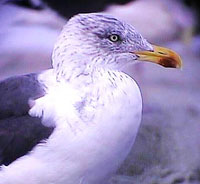 All photos were taken October 21, 1997 as the bird was present at the same locality last year.
All photos were taken October 21, 1997 as the bird was present at the same locality last year.Lesser Black-backed Gull
Doheny State Beach, Dana Point
Orange County, California
28 November 1998
 All photos were taken October 21, 1997 as the bird was present at the same locality last year.
All photos were taken October 21, 1997 as the bird was present at the same locality last year.
This afternoon, Robbie Fischer and I decided to take advantage of a respite between rain squalls to try for the returning adult Lesser Black-backed Gull at Doheny State Beach where we were joined by Kaaren Perry. The tide was low, and thousands of gulls, mostly California and Western, but including Ring-billed and Heerman's and Herring were standing at the San Juan Creek mouth. I was pleased to locate the Lesser Black-backed Gull relatively quickly and we spent about 30 minutes studying it and taking notes. Also during this time we took shelter briefly during a squall.
The following is based on notes taken while watching the bird:
The mantle was about the same shade of dark gray as adjacent Western Gulls of the race L. o. wymani, but the bird could be easily picked out from the many Western Gulls by the heavy streaking on its head. These streaks extended down onto the breast, but were much more sparse there. The streaks were heaviest on the nape and around the eye where they became decidedly smudgy. The lores and forehead were the palest part of the head, with finer, paler streaks in those areas.
The eye was very pale, almost white and this contrasted with a blackish outline to the eye, with a dark crescent visible in front of the eye. This may have been dark orbital skin, but I'm not sure.
The bill was much thinner than adjacent Western Gulls and had a large elongated red spot along the lower mandible, much larger and more extensive than on any other gull present. The rest of the bill was yellow, but the distal half of the upper mandible was suffused with orange. The bill shape was more like a Herring Gull, with the culmen starting to curve down at about the midpoint and the gonydeal angle was much less prominent than on Western Gull. The inner mouth lining and tongue appeared bright red when the bird yawned.
The legs seemed relatively long and were a rather bright yellow color including the toes and the webs which were nearly always visible. Other gulls frequently waded in the water, but the Lesser Black-backed seemed to like to stand on rocks on the sand bar in an effort to keep its feet dry. The intertarsal joint was somewhat swollen, similar to Western Gull, but not as much as on California Gull.
As the bird preened it was possible to see individual primaries. It was clear that the bird was in the midst of primary molt, with p1-p6 fresh and p7-p10 old. P6 was visible behind the folded secondaries and had a conspicuous white tip as did all the inner primaries seen while the bird preened. The outer primaries were duller black and lacked white tips. P10 had a larger white mirror, visible on the underside, and a narrow black tip.
The bird seemed to show a partly worn white tertial crescent and a single white scapular spot.
The bird was clearly larger than adjacent California Gulls, but only marginally smaller than some of the adjacent (female?) Western Gulls. In fact the bird had a rather flat crown and appeared to be on the large end for Lesser Black-backed, suggesting that it may have been a male.
Discussion
Recently, the question of distinguishing Lesser Black-backed Gull (Larus fuscus) from Heuglin's Gull
(L. ? heuglini) which breeds in northern Russia and could reach North America. Heuglin's Gull is sometimes
regarded as a race of Lesser Black-backed, or a race of Herring or a separate species (Siberian Gull) with two
or three races. There is an Alaska record of Lesser Black-backed which should probably be reconsidered in light
of the possibility of Heuglin's Gull.
Thanks to Dan Singer I have reviewed a copy of "The status of 'Lesser Black-backed Gulls' of heuglini,
graellsii and intermedius type in Finland" by Toni Eskelin and Jouni Pursiainen (Alula 4:42-54,
1998). This paper contradicts some previously claimed characters in "The Macmillan Birder's Guide to European
and Middle Eastern Birds," especially the claim about the extent of dark on the outer primaries.
Looking at the published photos and the text I see two characters which may be helpful. Heuglini has
a smaller white mirror on p10 and is not as close to the tip as in graellsii. This is mentioned in the text.
Also the photos in the paper seem to show graellsii with a broader red spot on the mandible and this is
a character which I think may be helpful.
I see no reason why our bird is not graellsii. The white spot on p10 is very large and almost includes the
feather tip. This may be seen in the attached photo. Also this bird showed an extensive broad red spot on the mandible
consistent with graellsii.
--
Joseph Morlan
380 Talbot Avenue #206
Pacifica, CA 94044